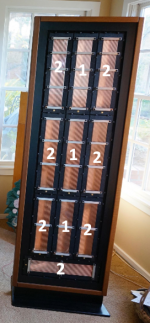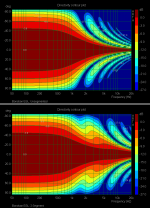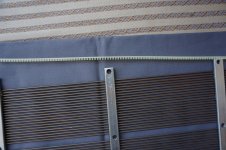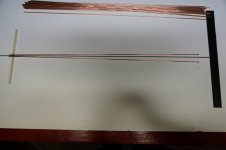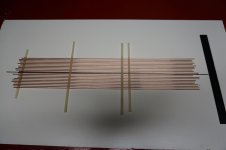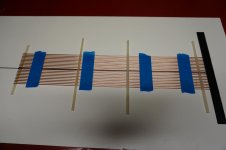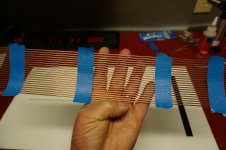Hello All,
Don't know if this is the proper description of this type of ESL; where the diaphragm size gradually gets larger from top to bottom. Something akin to a Sound Lab speaker.
As with most flat panel ESL's, my previous ones were very restrictive in listening position; I needed a tennis ball strategically hanging from the ceiling where my nose should be for optimum imaging. An inch side to side was noticeable and could become very tiring.
From reading several post at DIY on dispersion it seems I had three choices to broaden the 'sweet spot': 1-angled or curved panels, 2-segmented wire stators using resistors to vary the frequency, or 3-decrease the size of the radiating area.
I knew curved was out of the question for my abilities, while angled panels might have future possibilities. Segmented stators showed promise, but for my limited knowledge of electronics seemed a little too complicated, especially for the type of wire stator I'm familiar with building. That left smaller 'cell' panels which I thought would be the easiest to build, but at the cost of diminished output and bass response.
A review on a Sound Lab speaker made me think that gradually increasing the size of the diaphragm possibly could help with the two issues of smaller diaphragms. I am sure I've read posts here at DIY that question the effectiveness of this design, but figured it might be fun to give a try. It was never the intention to build a complete system initially, just a few experimental panels to start out. However after making the jigs and templates, I found myself in full production mode. Having a blast. Just like a kid building a giant model kit.
Had no idea of proper sizing, specs, formulas, etc.. Just dove into it. From a little research, a 3 inch width sounded like it should work well. The Sound Lab reviewer seemed to think that the length started out at 2 1/2 inches so thats where I began. I just randomly chose a 1/2 inch increase for each diaphragm. Since I wanted to reuse my existing Magnepan wood moulding and base, the 1/2 increases took me down to a final diaphragm length of 6 1/2 inches. I later added a two cell panel of 7 inches horizontally(still not sure if that was a mistake).
For ease of construction(although much more time consuming!), smaller plastic panel frames were used. All are 5 inches wide and average around 17 inches in length. I figured this way if I ever wanted to add on I could build more, or eventually have two rows facing forward and one row on each side slightly angled for even better dispersion.
I'm a slow typer and getting a little tired so will give some detailed impressions later. I will say this, though, the sound output is diminished, but not by much. The bass response is lower than the older panels but inconsistent. The dispersion is greatly improved! I can now swing the tennis ball a foot side to side. More importantly I can wake up from a stupor in my listening chair with my head nodded to one side and still be hearing a good image.
Below are a few pictures. Wished they were more clear, but the camera didn't always like focusing on the stators. Will post more if there's interest. Any comments or suggestions are greatly appreciated.
Bondsan
Don't know if this is the proper description of this type of ESL; where the diaphragm size gradually gets larger from top to bottom. Something akin to a Sound Lab speaker.
As with most flat panel ESL's, my previous ones were very restrictive in listening position; I needed a tennis ball strategically hanging from the ceiling where my nose should be for optimum imaging. An inch side to side was noticeable and could become very tiring.
From reading several post at DIY on dispersion it seems I had three choices to broaden the 'sweet spot': 1-angled or curved panels, 2-segmented wire stators using resistors to vary the frequency, or 3-decrease the size of the radiating area.
I knew curved was out of the question for my abilities, while angled panels might have future possibilities. Segmented stators showed promise, but for my limited knowledge of electronics seemed a little too complicated, especially for the type of wire stator I'm familiar with building. That left smaller 'cell' panels which I thought would be the easiest to build, but at the cost of diminished output and bass response.
A review on a Sound Lab speaker made me think that gradually increasing the size of the diaphragm possibly could help with the two issues of smaller diaphragms. I am sure I've read posts here at DIY that question the effectiveness of this design, but figured it might be fun to give a try. It was never the intention to build a complete system initially, just a few experimental panels to start out. However after making the jigs and templates, I found myself in full production mode. Having a blast. Just like a kid building a giant model kit.
Had no idea of proper sizing, specs, formulas, etc.. Just dove into it. From a little research, a 3 inch width sounded like it should work well. The Sound Lab reviewer seemed to think that the length started out at 2 1/2 inches so thats where I began. I just randomly chose a 1/2 inch increase for each diaphragm. Since I wanted to reuse my existing Magnepan wood moulding and base, the 1/2 increases took me down to a final diaphragm length of 6 1/2 inches. I later added a two cell panel of 7 inches horizontally(still not sure if that was a mistake).
For ease of construction(although much more time consuming!), smaller plastic panel frames were used. All are 5 inches wide and average around 17 inches in length. I figured this way if I ever wanted to add on I could build more, or eventually have two rows facing forward and one row on each side slightly angled for even better dispersion.
I'm a slow typer and getting a little tired so will give some detailed impressions later. I will say this, though, the sound output is diminished, but not by much. The bass response is lower than the older panels but inconsistent. The dispersion is greatly improved! I can now swing the tennis ball a foot side to side. More importantly I can wake up from a stupor in my listening chair with my head nodded to one side and still be hearing a good image.
Below are a few pictures. Wished they were more clear, but the camera didn't always like focusing on the stators. Will post more if there's interest. Any comments or suggestions are greatly appreciated.
Bondsan
Attachments
Hi Bondsan,
I love the cleanness of your design. I am somewhat familiar with Soundlab's "distributed resonance" scheme but I've never had an opportunity to hear their speakers play.
As I recall Soundlab applied for a patent on it which included a quite detailed description with illustrations-- so you might try searching for that. I'm not sure if the patent was granted or may have even been revoked, however, as there was controversy over who actually came up with the idea. Basically, I think, it breaks up the diaphragm's drum head resonance such that, instead of having a really loud resonance in a narrow band of frequencies, you get a bunch of less loud resonances spread out over a wider frequency band. And the resonances are used to boost up the bass band overall, above what it would have been with a single/un-sectioned diaphragm.
I also recall some comments by Roger Sanders rejecting the distributed resonance approach on the basis that the multiple resonances remain high-Q, uncontrolled motion distorting a wider bandwidth.
ML also applies the distributed resonance approach on their hybrid speakers, I think to boost up the midbass a bit and prevent the suck-out effect.
Your speakers are very neatly done. Since your panels are wire stators, I'm sure you could still apply the electrical segmentation scheme, with only slight modifications. I'm a complete dummy with electronics myself but Bolserst's Excel calculator makes it easy.
Beautiful speakers!
Jazz
I love the cleanness of your design. I am somewhat familiar with Soundlab's "distributed resonance" scheme but I've never had an opportunity to hear their speakers play.
As I recall Soundlab applied for a patent on it which included a quite detailed description with illustrations-- so you might try searching for that. I'm not sure if the patent was granted or may have even been revoked, however, as there was controversy over who actually came up with the idea. Basically, I think, it breaks up the diaphragm's drum head resonance such that, instead of having a really loud resonance in a narrow band of frequencies, you get a bunch of less loud resonances spread out over a wider frequency band. And the resonances are used to boost up the bass band overall, above what it would have been with a single/un-sectioned diaphragm.
I also recall some comments by Roger Sanders rejecting the distributed resonance approach on the basis that the multiple resonances remain high-Q, uncontrolled motion distorting a wider bandwidth.
ML also applies the distributed resonance approach on their hybrid speakers, I think to boost up the midbass a bit and prevent the suck-out effect.
Your speakers are very neatly done. Since your panels are wire stators, I'm sure you could still apply the electrical segmentation scheme, with only slight modifications. I'm a complete dummy with electronics myself but Bolserst's Excel calculator makes it easy.
Beautiful speakers!
Jazz
I'd love to see any construction details that you'd care to share. Transformer type? Coating material and method?
Really lovely work.
Really lovely work.
Hi CharlieM,
Thanks for the kind words and suggestions. The many times I've visited your excellent website have been most helpful. I like your idea of possibly segmenting the panels. There would only be 10 segments, but any improvements are always welcomed.
Hello Sy,
The transformers are OPT's from an old Dyna ST70. From much help here, especially Bolserst, I was finally able to set them up correctly with the bias supply. They only have a small turns ratio of 1:45 but sound just fine. I may change or add onto them in the future. The bias supply is an EMCO F40 HV unit controlled by a LM317 module. The EMCO was $55 on Ebay, and the LM317 was around $15 from Amazon. While not cheap, the price was reasonable for an easily assembled adjustable power supply, especially for a person like me with limited electronic knowledge. I've notice the same Ebay seller now has some 'B' stock F40's for only $40 and a few E40's for only $30. I bought a second 'A' stock F40 for possible future use about a month ago, but guess I should have waited.
The stators are made with RG45 1/16" copper coated welding rods epoxied to 1/8 x 1/2" aluminum bars. The bottom stator bar has a 1/4" copper conductive tape across it that the rods are soldered to for continuity. Their construction is very time consuming, but fun. The diaphragm frames are made out of ABS plastic; very easy to work with compared to polystyrene-terrible stuff. I will post some notes and pictures on the construction later on. Below are pictures of the bias supply and the stators with their corresponding ABS frames. Thanks for your interest.
Bondsan
Thanks for the kind words and suggestions. The many times I've visited your excellent website have been most helpful. I like your idea of possibly segmenting the panels. There would only be 10 segments, but any improvements are always welcomed.
Hello Sy,
The transformers are OPT's from an old Dyna ST70. From much help here, especially Bolserst, I was finally able to set them up correctly with the bias supply. They only have a small turns ratio of 1:45 but sound just fine. I may change or add onto them in the future. The bias supply is an EMCO F40 HV unit controlled by a LM317 module. The EMCO was $55 on Ebay, and the LM317 was around $15 from Amazon. While not cheap, the price was reasonable for an easily assembled adjustable power supply, especially for a person like me with limited electronic knowledge. I've notice the same Ebay seller now has some 'B' stock F40's for only $40 and a few E40's for only $30. I bought a second 'A' stock F40 for possible future use about a month ago, but guess I should have waited.
The stators are made with RG45 1/16" copper coated welding rods epoxied to 1/8 x 1/2" aluminum bars. The bottom stator bar has a 1/4" copper conductive tape across it that the rods are soldered to for continuity. Their construction is very time consuming, but fun. The diaphragm frames are made out of ABS plastic; very easy to work with compared to polystyrene-terrible stuff. I will post some notes and pictures on the construction later on. Below are pictures of the bias supply and the stators with their corresponding ABS frames. Thanks for your interest.
Bondsan
Attachments
I will post some notes and pictures on the construction later on.
Looking forward to that! I'd be very interested to see the tricks you used in construction.
Wow...thank for the info.......keep up the great work....
I don't care for the sound of the SL.....but if you can drive yours I bet they sound better.....
I don't care for the sound of the SL.....but if you can drive yours I bet they sound better.....
A few comments on how these things sound.
As mentioned before the dispersion is much better; I could live with them as they are but always willing to tinker. There is a lush sound to them that the older panels did not have. The highs were crisp and clear, but just a tad on the bright side, so I replaced the 1 ohm series resistor with a 2 ohm and now they're just about right. Cymbals have a nice metallic sheen that lingers. Little if any female sibilance. Voices, natural. Wonderful decay and ambience in the music. I am starting to enjoy again some my old classical recordings I haven't played in a long time.
And now we come to the lower frequencies. These things have a surprising amount of bass, although not the cleanest. Electric guitar bass sounds pretty good, but the panels will not keep up with lowest plucked notes. They try, but the sound is very diminished.
Then there's acoustic bass. One of my favorite recordings that I use as a reference is 'Sinatra at the Sands'. Sinatra's voice, Basie's orchestra, the ambient sounds of the audience, the hand clapping, just sound natural and wonderful, the best I've heard.....except for the acoustic bass. There is a slight panel resonance causing a little booming occasionally . It's not as bad as my previous one bass note ESL's; not only did they play the music but when it came to the lower notes, they wanted to be part of the music. A little disappointing since I beefed up the thickness of the wood panel just so this wouldn't happen.
Is there anything I can do besides clamping 4x4's or concrete bricks to the sides of the wood frame? Some kind of damping material, lead weights? What do the commercial ESL makers use?
Other than that, I'm extremely happy with how they sound.
Bondsan
As mentioned before the dispersion is much better; I could live with them as they are but always willing to tinker. There is a lush sound to them that the older panels did not have. The highs were crisp and clear, but just a tad on the bright side, so I replaced the 1 ohm series resistor with a 2 ohm and now they're just about right. Cymbals have a nice metallic sheen that lingers. Little if any female sibilance. Voices, natural. Wonderful decay and ambience in the music. I am starting to enjoy again some my old classical recordings I haven't played in a long time.
And now we come to the lower frequencies. These things have a surprising amount of bass, although not the cleanest. Electric guitar bass sounds pretty good, but the panels will not keep up with lowest plucked notes. They try, but the sound is very diminished.
Then there's acoustic bass. One of my favorite recordings that I use as a reference is 'Sinatra at the Sands'. Sinatra's voice, Basie's orchestra, the ambient sounds of the audience, the hand clapping, just sound natural and wonderful, the best I've heard.....except for the acoustic bass. There is a slight panel resonance causing a little booming occasionally . It's not as bad as my previous one bass note ESL's; not only did they play the music but when it came to the lower notes, they wanted to be part of the music. A little disappointing since I beefed up the thickness of the wood panel just so this wouldn't happen.
Is there anything I can do besides clamping 4x4's or concrete bricks to the sides of the wood frame? Some kind of damping material, lead weights? What do the commercial ESL makers use?
Other than that, I'm extremely happy with how they sound.
Bondsan
Perhaps steal a trick from Acoustat and stick some thin felt on a portion of the rear radiating area?
Nice looks panels 🙂
I would recommend a single layer of 1/16” thick crafting felt on the back side of the panels.
For best damping, felt should be mounted flush with the rear stator wires.
The 2nd and 3rd pic attached to this post show a front and rear view of the felt mounted on one of my earlier ESLs.
mechanical-sectioning-vs-silicon-dots-resonance-control-post#35
Near field measurements show the effective damping provided for the resonance with minimal impact on the midrange and highs.
mechanical-sectioning-vs-silicon-dots-resonance-control-post#25
If interested, I had posted some measurements and additional information/patents on the Sound Lab distributed resonance here:
http://www.diyaudio.com/forums/plan...nge-electrostatic-question-2.html#post3968866
As SY suggested, the solution is to add some acoustic damping.Is there anything I can do besides clamping 4x4's or concrete bricks to the sides of the wood frame? Some kind of damping material, lead weights?
I would recommend a single layer of 1/16” thick crafting felt on the back side of the panels.
For best damping, felt should be mounted flush with the rear stator wires.
The 2nd and 3rd pic attached to this post show a front and rear view of the felt mounted on one of my earlier ESLs.
mechanical-sectioning-vs-silicon-dots-resonance-control-post#35
Near field measurements show the effective damping provided for the resonance with minimal impact on the midrange and highs.
mechanical-sectioning-vs-silicon-dots-resonance-control-post#25
As a first experiment with segmentation, I would recommend splitting the panels into 2 groups as shown in the attached pic. Group 1 would be connected directly to the step-up transformer. Group 2 would be connected to group 1 through a resistor. Although it is only 2 segments, it will provide a nice improvement in dispersion. If you can tell me the thickness of your spacers that set the distance between the stator rods and the diaphragm, I can calculate the resistor values for you to use.…I like your idea of possibly segmenting the panels. There would only be 10 segments, but any improvements are always welcomed.
If interested, I had posted some measurements and additional information/patents on the Sound Lab distributed resonance here:
http://www.diyaudio.com/forums/plan...nge-electrostatic-question-2.html#post3968866
Attachments
Thank you Sy and Bolserst for the felt recommendation.
I know it's been mentioned before but I always assumed it was for damping the high frequencies, with the lows just weaving their way through.
Bought some craft felt today and will experiment with it tomorrow. As you can see from the rear shot of the panels, the stators are recessed 2 inches from the back due to the wooden mounting frames. Will it be ok to cut the felt the size of the wooden frames and just sorta stuff it in there, or do I need to somehow stretch it tightly across the stators? I might even start with one single piece of felt stretched across the back, 2 inches away from the stators just for simplicity and play some Sinatra.
Bolserst, in one of your reference posts, you measured a very slight improvement with felt or silkscreen placed between the diaphragm and stators, which I can also try if you think in my scenario it would be worthwhile.
My stator/diaphragm gap is 1/16", a tad more if you include the adhesive, if that's important. Thanks a bunch for doing this.
Bondsan
I know it's been mentioned before but I always assumed it was for damping the high frequencies, with the lows just weaving their way through.
Bought some craft felt today and will experiment with it tomorrow. As you can see from the rear shot of the panels, the stators are recessed 2 inches from the back due to the wooden mounting frames. Will it be ok to cut the felt the size of the wooden frames and just sorta stuff it in there, or do I need to somehow stretch it tightly across the stators? I might even start with one single piece of felt stretched across the back, 2 inches away from the stators just for simplicity and play some Sinatra.
Bolserst, in one of your reference posts, you measured a very slight improvement with felt or silkscreen placed between the diaphragm and stators, which I can also try if you think in my scenario it would be worthwhile.
My stator/diaphragm gap is 1/16", a tad more if you include the adhesive, if that's important. Thanks a bunch for doing this.
Bondsan
Try cutting the felt about 10-20% smaller than the stator open area, then glue it directly to the stator (on the outside!). A little spray adhesive on the felt will work fine. When I first got my Acoustats, the felt had been removed and I'd get some boom and panel-slap on loud bass notes. The felt cured the issue completely.
It’s actually the opposite way around. The reason is because of the nature of the air load on the diaphragm. At high frequencies, there is a large resistive component. At low frequencies with wavelengths larger than the panels the resistive part of the air load gets smaller and smaller and is the reason why the primary resonance of the diaphragm is not well damped. The felt acts like an acoustic resistor that you put in series with the air load. So, at high frequencies where the air load already has a large resistive component, it has little effect. But at low frequencies, the felt adds much more resistance than the air load does. This provides damping for the diaphragm resonance.I know it's been mentioned before but I always assumed it was for damping the high frequencies, with the lows just weaving their way through
Stretched across the back 2” from the panels will have some effect, but it won’t get you down to the Q level where string bass is going to sound right. I would recommend mounting directly to the rear stator frame of each panel with double-sided tape as shown in the pic below. You could also cut separate felt pieces to go in between each set of cross bars if you would prefer to leave the cross bars uncovered.Will it be ok to cut the felt the size of the wooden frames and just sorta stuff it in there, or do I need to somehow stretch it tightly across the stators? I might even start with one single piece of felt stretched across the back, 2 inches away from the stators just for simplicity and play some Sinatra.
I’ll run some number tonight and get back with you on some recommended resistors values.My stator/diaphragm gap is 1/16", a tad more if you include the adhesive, if that's important.
Attachments
Last edited:
As far as construction goes, why not start with the most time consuming and difficult portion of assembly-the wire stators. As mentioned previously they're made with 1/16" RG45 copper coated welding rod and 1/8 x1/2" aluminum bars.
The aluminum crossbars are the most tedious and boring to construct since in my particular design over 150 bars were needed. Yet they are the most important piece in the stator construction as they need to be made fairly accurately in order for the front and rear stator assemblies screw holes to line up.
The bars come in 12 foot lengths and had to be cut into 4 inch pieces(the diaphragm width is 3 inches and at least 1/2" overlap on each side of the plastic frame is necessary. However, the next stators I build will have at least 9/16" so the screw holes are not as close to the edge of the frame). The first attachment below is the homemade miter box used to cut the bars. At first they were cut one at a time with a hacksaw, then two at a time, then five using a Sawzall.
Now comes the real tedious part; the screw holes, but the most important key. The second attachment below is the crossbar jig with one of the many bar templates needed( the holes become too worn after about twenty to thirty uses). The first holes from the templates are 1/8' pilot holes. They are then drilled out to 1/4" and slightly counter sunk to remove any burrs. After a while you kinda get to know which bars won't work. I could only make about twenty or twenty five at a time without becoming tired. I'd then go work on another project. If I had a drill press it would have been much easier and more accurate. The next time I'll use one, even if I have to get it from Harbor Freight.
The third attachment is the crossbar jig to hold the bars in place as the wires are glued. It is made out of melamine shelving and strips of the 1/16' thick ABS plastic. The melamine is very flat and has a semi smooth surface thats works well with the double sided tape that holds the ABS strips securely. Once you know the distances for your crossbars, you carefully lay it out on the melamine, making sure all is square and aligned(very important!). Scor-Tape works great for holding the plastic strips down, and if need be, can be pulled up if some miner adjustments are required. The bars should be a snug fit but not too tight, just enough for the bars to slide in and out easily.
Fourth attachment. The bar strips should be about 1/2" shorter than the bars so that when the wire glue has dried, the assembly can be lifted off the jig. Since the ABS is 1/16" and the crossbars are 1/8", there is enough clearance for the glue and wires. A little masking tape on the ends keeps the crossbars in place.
Fifth attachment. The wires on the jig. How they got there will be the next chapter.
Bondsan
The aluminum crossbars are the most tedious and boring to construct since in my particular design over 150 bars were needed. Yet they are the most important piece in the stator construction as they need to be made fairly accurately in order for the front and rear stator assemblies screw holes to line up.
The bars come in 12 foot lengths and had to be cut into 4 inch pieces(the diaphragm width is 3 inches and at least 1/2" overlap on each side of the plastic frame is necessary. However, the next stators I build will have at least 9/16" so the screw holes are not as close to the edge of the frame). The first attachment below is the homemade miter box used to cut the bars. At first they were cut one at a time with a hacksaw, then two at a time, then five using a Sawzall.
Now comes the real tedious part; the screw holes, but the most important key. The second attachment below is the crossbar jig with one of the many bar templates needed( the holes become too worn after about twenty to thirty uses). The first holes from the templates are 1/8' pilot holes. They are then drilled out to 1/4" and slightly counter sunk to remove any burrs. After a while you kinda get to know which bars won't work. I could only make about twenty or twenty five at a time without becoming tired. I'd then go work on another project. If I had a drill press it would have been much easier and more accurate. The next time I'll use one, even if I have to get it from Harbor Freight.
The third attachment is the crossbar jig to hold the bars in place as the wires are glued. It is made out of melamine shelving and strips of the 1/16' thick ABS plastic. The melamine is very flat and has a semi smooth surface thats works well with the double sided tape that holds the ABS strips securely. Once you know the distances for your crossbars, you carefully lay it out on the melamine, making sure all is square and aligned(very important!). Scor-Tape works great for holding the plastic strips down, and if need be, can be pulled up if some miner adjustments are required. The bars should be a snug fit but not too tight, just enough for the bars to slide in and out easily.
Fourth attachment. The bar strips should be about 1/2" shorter than the bars so that when the wire glue has dried, the assembly can be lifted off the jig. Since the ABS is 1/16" and the crossbars are 1/8", there is enough clearance for the glue and wires. A little masking tape on the ends keeps the crossbars in place.
Fifth attachment. The wires on the jig. How they got there will be the next chapter.
Bondsan
Attachments
Here are the details for modifying your panels to a 2 segment design.
The 10 panels are split into 2 groups as shown in the first pic.
The schematic shows how to connect the two groups with two 100K resistors.
With your step-up ratio, you can use any 2Watt or larger metal oxide or metal film resistor.
The directivity plots show the improvement in dispersion.
Sweet spot will be widened and the music will sound much more balanced when walking around the room outside of the sweet spot.
***
Almost forgot to mention, since this segmentation reduced the effective radiating area in the top octaves you will likely need to change your primary damping resistor back to 1 ohm. You had mentioned increasing it to 2 ohm to address the overly bright response.
The 10 panels are split into 2 groups as shown in the first pic.
The schematic shows how to connect the two groups with two 100K resistors.
With your step-up ratio, you can use any 2Watt or larger metal oxide or metal film resistor.
The directivity plots show the improvement in dispersion.
Sweet spot will be widened and the music will sound much more balanced when walking around the room outside of the sweet spot.
***
Almost forgot to mention, since this segmentation reduced the effective radiating area in the top octaves you will likely need to change your primary damping resistor back to 1 ohm. You had mentioned increasing it to 2 ohm to address the overly bright response.
Attachments
Last edited:
Hi Bolserst,
Thank you so much for taking the time to design and calculate the conversion of my ESL's over to segmentation. Looking forward to the improved sound.
Applied felt directly to the back stators and sure enough the boom is almost completely gone. Simple fix. What I don't understand is why the bass is soft and polite sounding. I certainly didn't expect these things to be full range, somewhere below 100hz, which I think they are capable of, but what I did expect was what low frequencies they were capable of, would be tight and clean. The bass is not bad, just different. A large surface area with very little excursion in a dynamic woofer usually equates to good control and tight bass.
I've never actually heard a full range stat before, so maybe that's just how they sound. Or there's something wrong with mine. Interesting.
Will try to get back to construction notes later tonight or tomorrow.
Thank you so much for taking the time to design and calculate the conversion of my ESL's over to segmentation. Looking forward to the improved sound.
Applied felt directly to the back stators and sure enough the boom is almost completely gone. Simple fix. What I don't understand is why the bass is soft and polite sounding. I certainly didn't expect these things to be full range, somewhere below 100hz, which I think they are capable of, but what I did expect was what low frequencies they were capable of, would be tight and clean. The bass is not bad, just different. A large surface area with very little excursion in a dynamic woofer usually equates to good control and tight bass.
I've never actually heard a full range stat before, so maybe that's just how they sound. Or there's something wrong with mine. Interesting.
Will try to get back to construction notes later tonight or tomorrow.
The bass is going to sound soft and polite because the low end of a dipole ESL naturally rolls off. Equalize this roll off so the bass level matches the midrange and you will have a much more robust dynamic sounding bass. There are a few ways to do this. You can increase area at lower frequencies by adding more segments coupled by resistors. Alternatively you can approach the problem by increasing the step up ratio at lower frequencies. Acoustat and Soundlab both do this by increasing step up ratio from ~ 60:1 for mids & highs up to 200:1 for the bass...an effect bass boost of +10dB. Audiostatic uses a circuit they call Mirror-drive on some of their models to boost the low end by +6dB. You can also equalize the response with a shelving filter upstream of your power amplifier.What I don't understand is why the bass is soft and polite sounding…I've never actually heard a full range stat before, so maybe that's just how they sound. Or there's something wrong with mine.
A few links to previous posts on this topic you might find helpful:
1) Acoustat and Soundlab dual transformer setups to increase step-up ratio at low frequencies.
Soundlab Interface
Acoustat Interface
Acoustat response
2) Modeling of Acoustat showing natural bass roll-off and how it is equalized
Acoustat ESL response modeling
3) Audiostatic Mirror drive and passive shelving filter
http://www.diyaudio.com/forums/plan...cs-mirror-drive-diy-possible.html#post4589255
http://www.diyaudio.com/forums/plan...cs-mirror-drive-diy-possible.html#post4597057
One other thing we don’t know about your setup is the resonance frequencies of your panels. There is little output below resonance, so with some of your panels having much smaller sections, their resonance is likely > 100Hz so their area will not contribute any output in the bass range below 100 Hz. This may be another factor in your situation. Do you have access to a signal generator that you can use to sweep the bass range to identify what the panel resonance frequencies are?
In your situation, the passive shelving filter shown in links 3) above may be your best option.
Alternatively, if your preamp has tone controls, turning up the bass control may be all you need.
Now for the second most tedious job...cutting the wires to length.
Originally I tried the bulk method described on another post using bundled wires tightly held together with hose clamps, cutting with a metal blade(in my case on an arm saw). Somewhere I must have erred, cuz for me it was a total disaster. The first 3 or 4 rods cut ok, but the rest just fused themselves into one solid end piece. I decided to go back to cutting one at a time using a good set of wire cutters. Time consuming but good for developing a manly handshake. The wires should be about a 1/16 to 1/8" shorter than the end to end measurement of the cross bars.
Now the fun parts begin; pre making the wire assemblies to lay on the cross bar jig. Making a template with another piece of melamine easies the process. A straight line is drawn down the center of the melamine, with a strip of ABS positioned at right angle to the center line used as a stop. Placing a nylon edging grommet(attachment 1) with their teeth facing up on the template, the wires are ready for assembly. The grommet has marks for the center and ends. Starting with two wires that have both ends marked by a black sharpie,to indicate the center of the grid( I used an even number of wires-22, but with an odd amount- only one marked wire would be necessary), they are placed on the center of the grommet(Attachment 2).
Once all the wires are down, another grommet, now with its teeth down, is positioned next to the first up grommet and slid(or combed) down about five inches-aligning the wires as it goes(Attachment 3). This is repeated until the wires are evenly spaced end to end(Attachment 4). Making sure that the wires are centered on the line and the ends are evenly against the stop, carefully start laying some masking tape across the wires. Just enough to cover them, but not so much that the tape sticks to the melamine(Attachment 5). Try to mark where the cross bars will be so the tape does not get in the way of the glue. Now the grommets can be removed and the taped assembly can be carefully slid off the melamine, ready to be glued to the cross bars. Attachment 6. Fun
Next: Epoxying and soldering
Originally I tried the bulk method described on another post using bundled wires tightly held together with hose clamps, cutting with a metal blade(in my case on an arm saw). Somewhere I must have erred, cuz for me it was a total disaster. The first 3 or 4 rods cut ok, but the rest just fused themselves into one solid end piece. I decided to go back to cutting one at a time using a good set of wire cutters. Time consuming but good for developing a manly handshake. The wires should be about a 1/16 to 1/8" shorter than the end to end measurement of the cross bars.
Now the fun parts begin; pre making the wire assemblies to lay on the cross bar jig. Making a template with another piece of melamine easies the process. A straight line is drawn down the center of the melamine, with a strip of ABS positioned at right angle to the center line used as a stop. Placing a nylon edging grommet(attachment 1) with their teeth facing up on the template, the wires are ready for assembly. The grommet has marks for the center and ends. Starting with two wires that have both ends marked by a black sharpie,to indicate the center of the grid( I used an even number of wires-22, but with an odd amount- only one marked wire would be necessary), they are placed on the center of the grommet(Attachment 2).
Once all the wires are down, another grommet, now with its teeth down, is positioned next to the first up grommet and slid(or combed) down about five inches-aligning the wires as it goes(Attachment 3). This is repeated until the wires are evenly spaced end to end(Attachment 4). Making sure that the wires are centered on the line and the ends are evenly against the stop, carefully start laying some masking tape across the wires. Just enough to cover them, but not so much that the tape sticks to the melamine(Attachment 5). Try to mark where the cross bars will be so the tape does not get in the way of the glue. Now the grommets can be removed and the taped assembly can be carefully slid off the melamine, ready to be glued to the cross bars. Attachment 6. Fun
Next: Epoxying and soldering
Attachments
Hi Bolserst,
I do not have access to a signal generator, at least one that works. I will probably invest in a Minidsp REW setup, but that's a while away.
The bass that I am hearing does not seem to be diminished in loudness and actually has quite some weight to it. It does drop off very quickly. I wish I could be more specific but know that some low frequencies are missing from recordings I'm familiar with. I should point out that the bass I'm used to hearing comes from years of listening to Khorns, so that could be a unfair comparison.
The idea of employing different ratio transformers for equalization is interesting, but don't think I'm ready for that kind of sophistication. I do have another EMCO F40 and was wondering if I could accomplish similar results by using a second bias supply, increasing the voltage to some of the lower larger radiating panels, and maybe increasing the stator/diaphragm gap to 3/32" for larger excursions. Could this be a worthwhile future project? In the meantime I'll play with the tone controls. Thanks for looking into this.
Bondsan
I do not have access to a signal generator, at least one that works. I will probably invest in a Minidsp REW setup, but that's a while away.
The bass that I am hearing does not seem to be diminished in loudness and actually has quite some weight to it. It does drop off very quickly. I wish I could be more specific but know that some low frequencies are missing from recordings I'm familiar with. I should point out that the bass I'm used to hearing comes from years of listening to Khorns, so that could be a unfair comparison.
The idea of employing different ratio transformers for equalization is interesting, but don't think I'm ready for that kind of sophistication. I do have another EMCO F40 and was wondering if I could accomplish similar results by using a second bias supply, increasing the voltage to some of the lower larger radiating panels, and maybe increasing the stator/diaphragm gap to 3/32" for larger excursions. Could this be a worthwhile future project? In the meantime I'll play with the tone controls. Thanks for looking into this.
Bondsan
Hmmmm...from your description, it sounds like the separation and frequency of panel resonances may be the main issue.
Of course, it is hard to know without measuring, or at least sweeping to find the resonances of each panel group.
BTW, how far away from your speakers is the listening position?
Since you don't have a signal generator, here is a website where you can download a simple signal generator called "Tone" to drive your woofer amplifier from your computer. Click on sinusoid and then the play button at the top. There are two sliders at the bottom that let you change the frequency.
Tolvan Data
Alternatively, if you have a “smart phone”, there are plenty of free Apps that will do the job.
Just search for signal generator in the app store.
Some thoughts concerning getting more output by increasing gap and bias voltage:
1) Trying to boost the bass in any manner will be a losing proposition if the resonance is above the bass range you are trying to boost. You need a way to measure resonance to know how to adjust panel size and/or diaphragm tension to get the resonance frequency you need for efficient bass output.
2) Increasing the gap and bias voltage will actually result in less bass unless the step-up ratio is increased as well. A numerical example may help.
- Double the gap size leaving bias and step-up ratio the same = -12dB
- Double the gap size, double bias, leave step-up ratio the same = -6dB
- Double the gap size, double bias, double step-up ratio = 0dB (ie same loudness as you started with)
3) For a given step-up ratio, you want to use the smallest gap possible to get the highest output. BUT, you need to use a gap wide-enough to allow the diaphragm excursion needed to produce that output without hitting the stators. The lower the frequency you want to produce at a given SPL, the wider the gap needs to be….which requires higher bias voltage and step-up ratio to generator the required driving force on the diaphragm. For perspective, to get constant SPL the required diaphragm excursion increases by a factor of about 6 for a dipole line source for each octave lower you want your ESL to play. This explains why Sound Lab has 12 - 15 ft^2 diaphragm area in their full range ESLs.
Of course, it is hard to know without measuring, or at least sweeping to find the resonances of each panel group.
BTW, how far away from your speakers is the listening position?
Since you don't have a signal generator, here is a website where you can download a simple signal generator called "Tone" to drive your woofer amplifier from your computer. Click on sinusoid and then the play button at the top. There are two sliders at the bottom that let you change the frequency.
Tolvan Data
Alternatively, if you have a “smart phone”, there are plenty of free Apps that will do the job.
Just search for signal generator in the app store.
Some thoughts concerning getting more output by increasing gap and bias voltage:
1) Trying to boost the bass in any manner will be a losing proposition if the resonance is above the bass range you are trying to boost. You need a way to measure resonance to know how to adjust panel size and/or diaphragm tension to get the resonance frequency you need for efficient bass output.
2) Increasing the gap and bias voltage will actually result in less bass unless the step-up ratio is increased as well. A numerical example may help.
- Double the gap size leaving bias and step-up ratio the same = -12dB
- Double the gap size, double bias, leave step-up ratio the same = -6dB
- Double the gap size, double bias, double step-up ratio = 0dB (ie same loudness as you started with)
3) For a given step-up ratio, you want to use the smallest gap possible to get the highest output. BUT, you need to use a gap wide-enough to allow the diaphragm excursion needed to produce that output without hitting the stators. The lower the frequency you want to produce at a given SPL, the wider the gap needs to be….which requires higher bias voltage and step-up ratio to generator the required driving force on the diaphragm. For perspective, to get constant SPL the required diaphragm excursion increases by a factor of about 6 for a dipole line source for each octave lower you want your ESL to play. This explains why Sound Lab has 12 - 15 ft^2 diaphragm area in their full range ESLs.
- Status
- Not open for further replies.
- Home
- Loudspeakers
- Planars & Exotics
- Progressively Sized Wire Stators
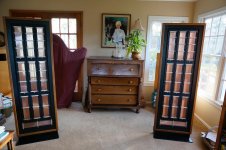
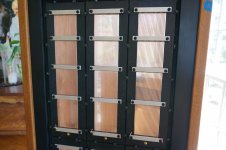


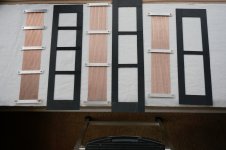
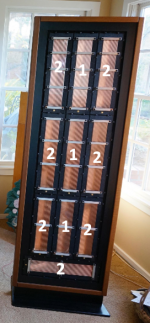


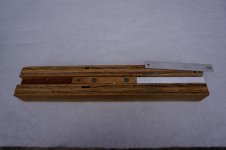
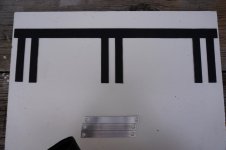
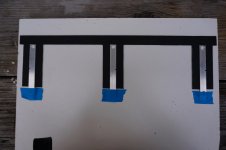
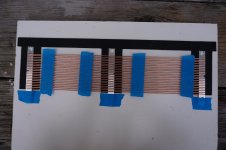
 Appreciate your work filling in the details!
Appreciate your work filling in the details!